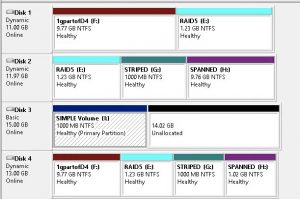Storage Management is an important topic for MCSA 70-410 exam and it is worth being clear about what various concepts mean and their relevance to day to day practice.
This article talks in a bit more detail of how Microsoft has moved on in the storage area. Sure there will be situations where the extra SAN feature will be desirable and entirely justified, however I think that for most run of the a mill use cases, you will find it hard to justify the SAN expenditure. Most of the time it comes down how happy you are with your support provider and the fact that many IT houses simply don’t have the guts to go for something radical like Windows Storage Spaces.
types of volumes:
- Simple:
- only possible on one disk (if you extend it on other dynamic disks, we have a spanned volume)
- no fault tolerance
- Spanned
- up to 32 disks
- no fault tolerance
- Stripped
- up to 32 disks
- no fault tolerance
- Mirrored
- fault tolerance, allows for 1 disk failure
- you can only have 2 disks in one mirrored disk volume
- Raid5
- at least 3 but no more than 32 disks (it will be interesting to see what number of disks gives you optimal performance in a Windows Raid5 Storage Volume, if this would be indeed a factor)
- fault tolerance, allows for 1 disk failure (and only 1 irrespective of the number of physical disks in the volume)
- ***rebuild time is VERY slow (I’ve tried it on 1GB volume) and I simply can’t imagine a production scenario where you would want to create a RAID5 volume in this way.
Storage Spaces: created in ‘File and Storage Services’ in Server Manager (same as Disk Volumes, only that there is another layer of abstraction – virtual disks that are created in this “soup” of disk space (storage pool)
So the storage ‘soup’ is called by Microsoft a storage pool. It really means exactly that a pool of storage, any storage.
Then you create your disks (virtual of course) for which, depending on the number and type of the physical disks involved (e.g. HDD and SSD, or just HDD), you get various options:
- Simple – basically a stripe.
- Mirror
- two way mirror, requires minimum 3 disks, protects from 1 disk failure
- three way mirror, requires minimum 5 disks, protects from 2 disks failure
- Parity
- single parity, requires 3 disks, protects from 1 disk failure
- dual parity requires 7 disks, protects from 2 disks failure

As an aside, [column count] (number of disks in a stripe) is a concept used in calculating how many disks you want in your Storage Space. This technet article gives a lot of detail and has a very useful table showing all you practically need to know to plan your storage. But the upshot of that is as I see it, if you want fault tolerance best to have ‘hot spares‘ or is it? Don’t expect your hot spares to become operational in an instant though.
From what I’ve seen in practice and understood from the literature, protection from failure, does not mean your data is going to remain online and available, it only means exactly that, protected, but possible offline. Not quite what you might have been used to when talking about fault tolerance, but here we go, take that as a warning. I didn’t have the time for a comprehensive test of options, but as far as the dual parity is concerned (the one that is supposed to protect from 2 drive failures), failing two drives will result in your disk becoming detached (unaccessible). Yes you can bring a different disk into the Storage Pool and your drive will automagically came back, so I guess your data has been protected from from the two disks failing afterall. However protection does not mean availability as one might be tempted to assume.
